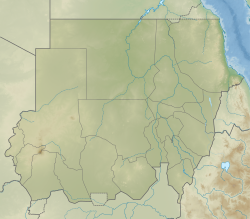| Wadi Milk Formation | |
|---|---|
| Stratigraphic range: Campanian-Maastrichtian | |
| Type | Geological formation |
| Unit of | Ash Shamaliyah |
| Sub-units | Wadi Abu Hashim Member |
| Lithology | |
| Primary | Sandstone |
| Other | Siltstone |
| Location | |
| Coordinates | 20°00′N30°00′E / 20.0°N 30.0°E |
| Approximate paleocoordinates | 4°24′N24°42′E / 4.4°N 24.7°E |
| Country | Sudan |
| Extent | Wadi Al-Malik-Bayuda Desert |
| Type section | |
| Named for | Wadi Al-Malik |
The Wadi Milk Formation is a geological formation in Sudan whose strata date back to the Late Cretaceous. Originally, the formation was thought to be Albian to Cenomanian, later research has provided dating to the Campanian to Maastrichtian. [1] Dinosaur remains are among the fossils that have been recovered from the formation. [2] It stretches from the lower Wadi Al-Malik across the Wadi Muqaddam into the Bayuda Desert. [3]
